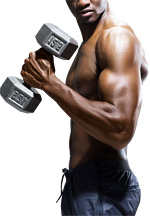6. Integrative Training
They say variety is the spice of life; well, it's also true for maximizing workouts. Your body has an amazing adaptation response to stress - it's called homeostasis. Knowing this fact can make a big difference in how you approach exercise.
You need to shock your system into changing by integrating other fitness routines into your regimen; if you stick with the same old program, your body will adapt and stop making progress. Examples include: yoga, Pilates, spin cycling, boxing, kickboxing, kettlebells, plyometrics and sprint running.
When was the last time you ran a flight of stairs? Try visiting the track and running bleachers for 15 minutes. You want maximum? That's at the top of the list. Your muscles will not know what hit them. You just might find yourself enjoying the challenge!
Notwithstanding the above suggestions, the most important component of maximizing your workout is actually a simple one, and it's completely under your control: desire. You have to push yourself with intensity and passion to improve your body. Yes, it will be difficult and challenging at times, but that is how we excel. You have the power to continually change your body for the better; all you have to do is go out and make it happen. As with all new fitness and exercise programs, make sure you can physically tolerate the new routine. Always get a medical clearance and physical evaluation prior to any new intensive training program.
 Do It Right
Do It Right
Not quite sure how to perform some of the example exercises mentioned in this article. Here are a few detailed descriptions to get you started. Remember to always talk to your doctor and/or trainer before starting any new exercise program, particularly if you're not familiar with how to perform a particular exercise. After all, getting hurt on day one isn't a great way to maximize your workout.
Squat to Stand: Bend at the waist, grabbing under your big toes. Keeping your arms straight and inside your knees, pull your hips down until they're between your ankles and lift your chest up. Then tuck your chin and try to straighten your legs, holding on to your toes as you straighten out your hips and toes.
Reverse Lunge Twist: Starting with your feet together, step back with your right leg into a lunge. Arch your back slightly while twisting your torso over your left leg and while reaching your right hand to the sky. Push back and out of the position into the next lunge. Make sure you lean back and rotate, firing your glute (butt) muscle on your back leg.
Lateral Lunge: Keep your toes pointed straight ahead and feet flat. Squat by sitting back and down onto your right leg, keeping your leg straight and the weight on the right leg's midfoot to heel. Squat as low as possible, keeping your left leg straight and holding this position for 2 seconds. Return to starting position and repeat.
Foam Hamstring: Place a foam roll under one or both of your hamstrings and let your body glide up and down the roll.
Perry Nickelston, DC, is clinical director of the Pain Laser Center in Ramsey, N.J., where he focuses on performance enhancement, corrective exercise and metabolic fitness nutrition To learn more about Dr. Nickelston, visit www.painlasercenter.com/Our_Practice.html.

